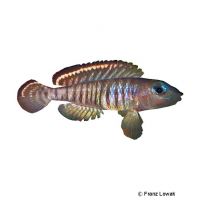Black Ocellatus (Neolamprologus speciosus)
| Black Ocellatus Neolamprologus speciosus | |
|---|---|
| Name | Black Ocellatus |
| Name Lat. | Neolamprologus speciosus |
| Synonym | Lamprologus speciosus |
| Family | Cichlids |
| Family lat. | Cichlidae |
| Order | Cichlids |
| Order lat. | Cichliformes |
| Origin | Lake Tanganyika |
| Habitat | Sandy intermediate zone |
| Diet | Carnivore |
| pH | 7.5-9.0 |
| Behavior | Semi-aggressive |
| Keeping | Pair, group |
| Care Level | Moderate |
| Reproduction | Cave spawner |
| Breeding | Moderately difficult |
| Life Span | 6-8 years |
| Protection | No |
| Metric Units | |
| Size | 4-6 cm |
| Temperature | 24-28 °C |
| Hardness | 15-18 °dH |
| Aquarium | ~ 120 l |
| US Units | |
| Size | 1.6"-2.4" |
| Temperature | 75-82 °F |
| Hardness | 267-320 ppm |
| Aquarium | ~ 30 gal |
Distribution and habitat
The distribution area of the White-banded Snail Cichlids is exclusively (endemic) the southwest of Lake Tanganyika. They inhabit the rocky zone above sandy bottoms with accumulations of empty snail shells (Neothauma snail), which serve them as living burrows, at 5-40 m depth.
Maintenance
The aquarium should have large free sandy areas, with a fine approx. 6 cm deep bottom substrate of sand suitable for digging and provide sufficient swimming space. There should be a few snail shells for each animal as living and breeding dens. Stones, roots and plants provide hiding places and serve to separate territories.
No ammonia, ammonium and nitrite should be detectable, the nitrate value should not exceed 100 mg/l. To ensure the water quality and the oxygen content, a filter adapted to the aquarium size and a heater are required, as well as lighting for the species-appropriate day-night rhythm of the animals.
Diet
In nature they feed mainly on insects, insect larvae and plankton. The food supply consists of live, frozen and dry food. For a balanced diet, feed once a day with a high-quality dry food for Tanganyika cichlids (flakes, granules, pellets) as well as cyclops, daphnia, artemia, plankton, etc. (live or frozen)
It is recommended to feed small portions several times a day. Only feed as much as will be eaten within a few minutes. A regular and varied diet promotes health and prevents deficiency symptoms.
Behaviour and compatibility
This relatively peaceful species should be kept in pairs or better in a group of 4-6 animals, where the number of females should predominate. They defend their snail shells including the immediate surroundings vehemently. Keeping a group is only recommended in a larger and richly structured tank. They can be socialized well with other small Lake Tanganyika cichlids. Basically, only compatible fish species with similar demands on water condition and water temperature should be socialized.
Sex dimorphism
The sexes are difficult to distinguish. The males are slightly larger than the paler, more rounded females at spawning time.
Reproduction and breeding
They are mating, non-monogamous cave breeders. The female buries a snail shell in the sand with the opening facing upwards, spawns in it (cave breeder) and fans the spawn with its fins sitting in front of the entrance, while the male defends the territory. After 2-3 days the fry hatch and swim free after about 10 days. They are guarded for some time before the brood care ends
Fry must be fed several times a day with special rearing food (e.g. Artemia nauplii, microworms). In community tanks breeding is hardly possible, because the fry are easy prey.
Important
As a substitute for the shell of the Neothauma snail is suitable, for example, that of the Roman snail. If there are too few snail shells for the fish, they tend to burrow heavily
The well-being of the fish should be checked regularly. Temperature should be checked daily, pH, hardness and nitrate levels at least every 14 days. Regular partial water changes are recommended, even if the contaminant level has not yet reached the upper limit. Sudden changes in water quality should be avoided. Newly introduced fish must be accustomed slowly to the water in the aquarium.
Further literature can be found in your pet store.
References
Text: Werner Winter; Image: Franz Lowak
Source: BMELV (1998): Tierschutzgutachten - Haltung von Zierfischen (Süßwasser); BAENSCH & RIEHL (2004): Aquarien Atlas Bd. 4, Mergus Verlag; ENGELMANN (2005): Zootierhaltung - Tiere in menschlicher Obhut: Fische, Verlag Harri Deutsch
- Gemäß § 21 Abs. 5 Tierschutzgesetz idgF
